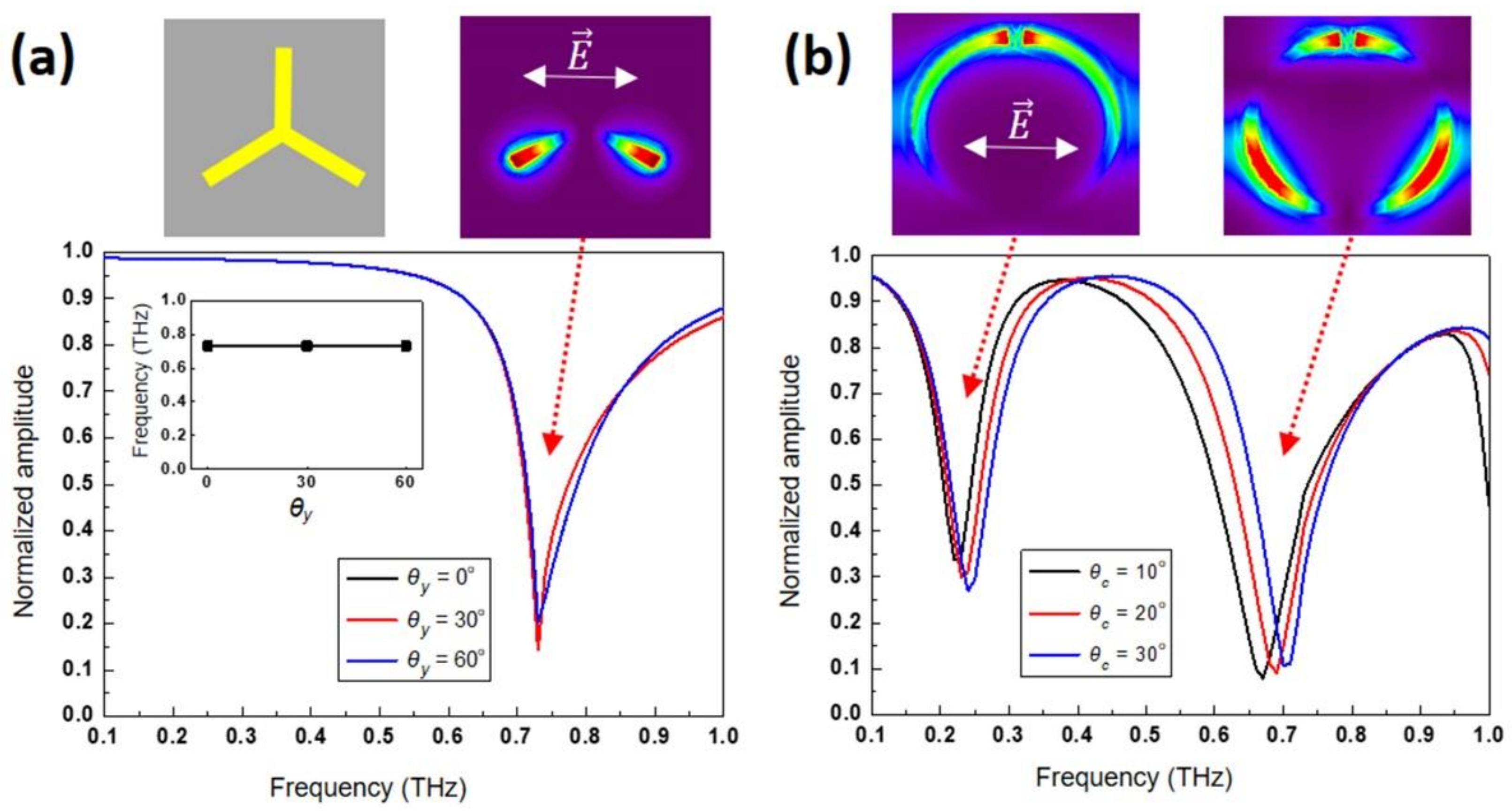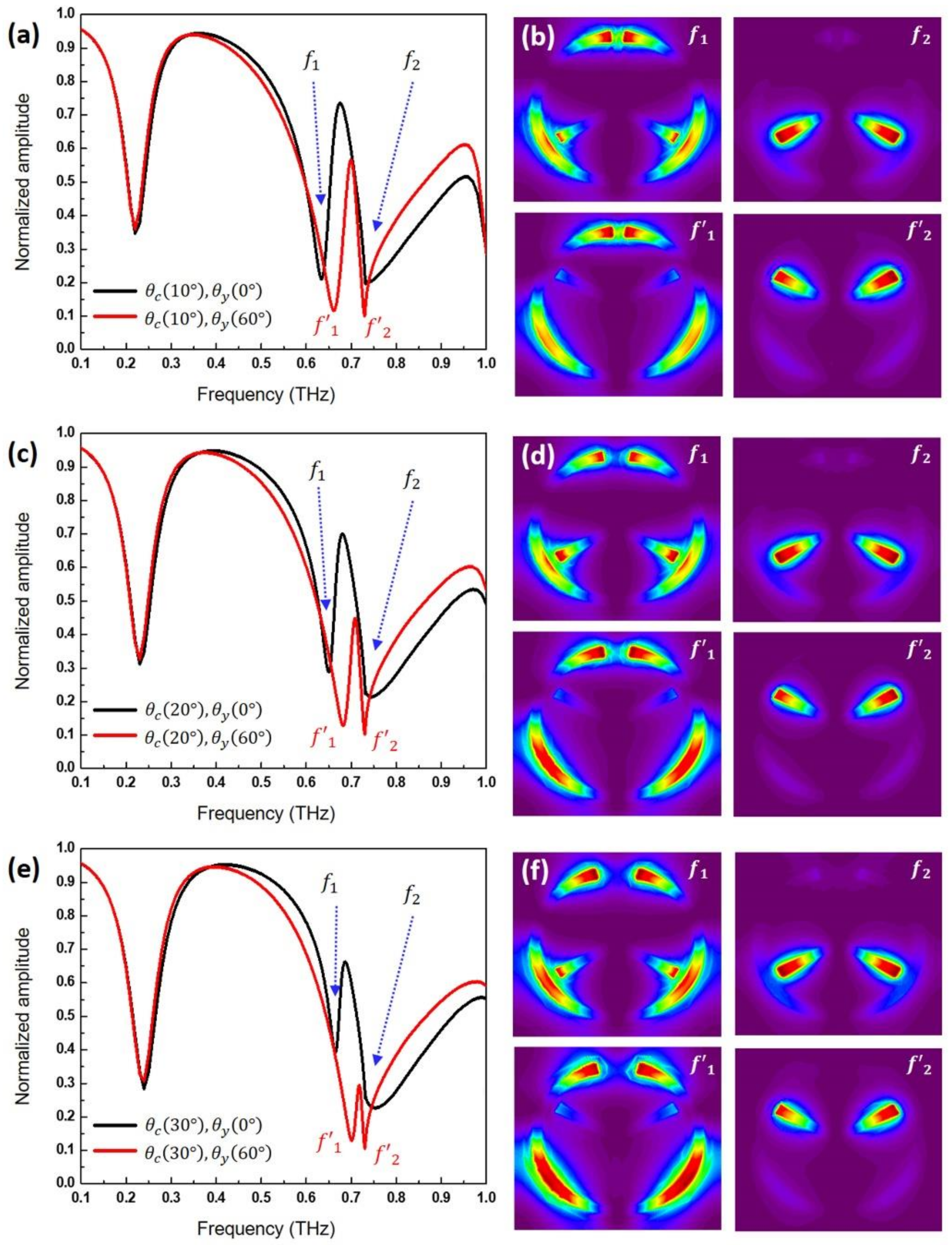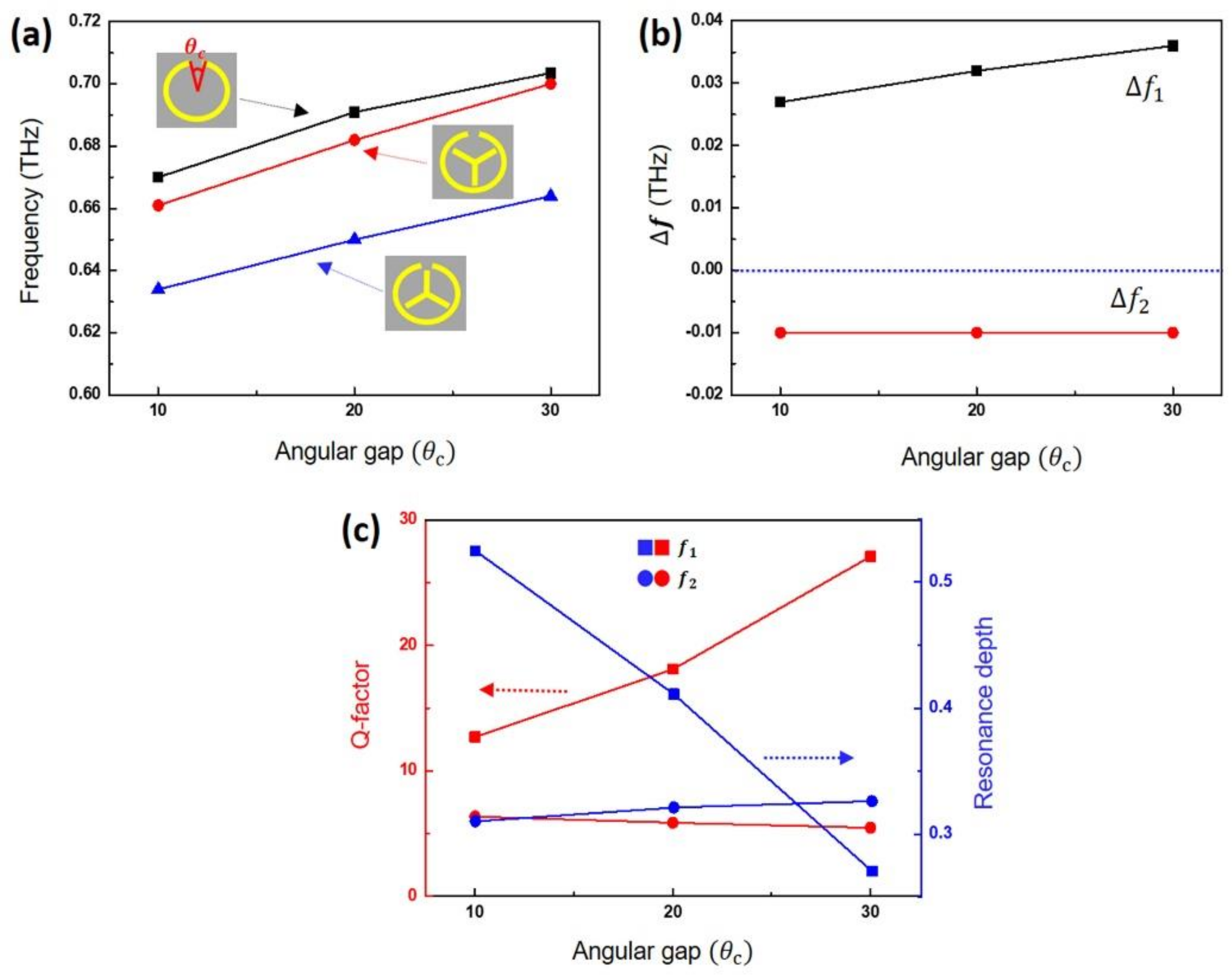Controllable Fano-like Resonance in Terahertz Planar Meta-Rotamers
Abstract
:1. Introduction
2. Design and Methods
3. Results and Discussion
4. Conclusions
Author Contributions
Funding
Institutional Review Board Statement
Informed Consent Statement
Data Availability Statement
Conflicts of Interest
References
- Cui, T.J.; Qi, M.Q.; Wan, X.; Zhao, J.; Cheng, Q. Coding metamaterials, digital metamaterials and programmable metamaterials. Light Sci. Appl. 2014, 3, e218. [Google Scholar] [CrossRef]
- Jung, J.; Park, H.; Park, J.; Chang, T.; Shin, J. Broadband metamaterials and metasurfaces: A review from the perspectives of materials and devices. Nanophotonics 2020, 9, 3165–3196. [Google Scholar] [CrossRef]
- Lee, J.-H.; Singer, J.P.; Thomas, E.L. Micro-/nanostructured mechanical metamaterials. Adv. Mater. 2012, 24, 4782–4810. [Google Scholar] [CrossRef]
- Zheludev, N.I.; Kivshar, Y.S. From metamaterials to metadevices. Nat. Mater. 2012, 11, 917–924. [Google Scholar] [CrossRef] [PubMed]
- Lee, I.-S.; Sohn, I.-B.; Kang, C.; Kee, C.-S.; Yang, J.-K.; Lee, J.W. High refractive index metamaterials using corrugated metallic slots. Opt. Express 2017, 25, 6365–6371. [Google Scholar] [CrossRef] [PubMed]
- Lee, J.W.; Seo, M.A.; Park, D.J.; Kim, D.S.; Jeoung, S.C.; Lienau, C.; Park, Q.H.; Planken, P.C.M. Shape resonance omni-directional terahertz filters with near-unity transmittance. Opt. Express 2006, 14, 1253–1259. [Google Scholar] [CrossRef] [PubMed] [Green Version]
- Liu, N.; Langguth, L.; Weiss, T.; Kästel, J.; Fleischhauer, M.; Pfau, T.; Giessen, H. Plasmonic analogue of electromagnetically induced transparency at the Drude damping limit. Nat. Mater. 2009, 8, 758–762. [Google Scholar] [CrossRef]
- Zhang, S.; Genov, D.A.; Wang, Y.; Liu, M.; Zhang, X. Plasmon-induced transparency in metamaterials. Phys. Rev. Lett. 2008, 101, 047401. [Google Scholar] [CrossRef] [Green Version]
- Ziemkiewicz, D.; Słowik, K.; Zielińska-Raczyńska, S. Ultraslow long-living plasmons with electromagnetically induced transparency. Opt. Lett. 2018, 43, 490–493. [Google Scholar] [CrossRef] [Green Version]
- Ling, Y.; Huang, L.; Hong, W.; Liu, T.; Luan, J.; Liu, W.; Lai, J.; Li, H. Polarization-controlled dynamically switchable plasmon-induced transparency in plasmonic metamaterial. Nanoscale 2018, 10, 19517–19523. [Google Scholar] [CrossRef]
- Hentschel, M.; Saliba, M.; Vogelgesang, R.; Giessen, H.; Alivisatos, A.P.; Liu, N. Transition from isolated to collective modes in plasmonic oligomers. Nano Lett. 2010, 10, 2721–2726. [Google Scholar] [CrossRef]
- Papasimakis, N.; Fedotov, V.A.; Zheludev, N.I.; Prosvirnin, S.L. Metamaterial analog of electromagnetically induced transparency. Phys. Rev. Lett. 2008, 101, 253903. [Google Scholar] [CrossRef] [Green Version]
- Schurig, D.; Mock, J.J.; Justice, B.J.; Cummer, S.A.; Pendry, J.B.; Starr, A.F.; Smith, D.R. Metamaterial electromagnetic cloak at microwave frequencies. Science 2006, 314, 977–980. [Google Scholar] [CrossRef] [Green Version]
- Liu, J.-Q.; Yu, J.-M. Electromagnetic resonances and their tunability in planar metamolecules isomer. Optik 2015, 126, 2858–2861. [Google Scholar] [CrossRef]
- Omaghali, N.E.J.; Tkachenko, V.; Andreone, A.; Abbate, G. Optical sensing using dark mode excitation in an asymmetric dimer metamaterial. Sensors 2014, 14, 272–282. [Google Scholar] [CrossRef]
- Yang, Z.-J.; Wang, Q.-Q.; Lin, H.-Q. Cooperative effects of two optical dipole antennas coupled to plasmonic Fabry–Pérot cavity. Nanoscale 2012, 4, 5308–5311. [Google Scholar] [CrossRef]
- Liu, N.; Weiss, T.; Mesch, M.; Langguth, L.; Eigenthaler, U.; Hirscher, M.; Sönnichsen, C.; Giessen, H. Planar metamaterial analogue of electromagnetically induced transparency for plasmonic sensing. Nano Lett. 2010, 10, 1103–1107. [Google Scholar] [CrossRef] [PubMed]
- Liu, N.; Kaiser, S.; Giessen, H. Magnetoinductive and electroinductive coupling in plasmonic metamaterial molecules. Adv. Mater. 2008, 20, 4521–4525. [Google Scholar] [CrossRef]
- Yang, P.; Xiao, Y.; Xiao, M.; Li, S. 6G wireless communications: Vision and potential techniques. IEEE Netw. 2019, 33, 70–75. [Google Scholar] [CrossRef]
- Dang, S.; Amin, O.; Shihada, B.; Alouini, M.-S. What should 6G be? Nat. Electron. 2020, 3, 20–29. [Google Scholar] [CrossRef] [Green Version]
- Singh, R.; Rockstuhl, C.; Lederer, F.; Zhang, W. Coupling between a dark and a bright eigenmode in a terahertz metamaterial. Phys. Rev. B 2009, 79, 085111. [Google Scholar] [CrossRef] [Green Version]
- Liu, M.; Tian, Z.; Zhang, X.; Gu, J.; Ouyang, C.; Han, J.; Zhang, W. Tailoring the plasmon-induced transparency resonances in terahertz metamaterials. Opt. Express 2017, 25, 19844–19855. [Google Scholar] [CrossRef]
- Baqir, M.A.; Choudhury, P.K.; Farmani, A.; Younas, T.; Arshad, J.; Mir, A.; Karimi, S. Tunable plasmon induced transparency in graphene and hyperbolic metamaterial-based structure. IEEE Photonics J. 2019, 11, 1–10. [Google Scholar] [CrossRef]
- Yao, F.; Li, F.; He, Z.; Liu, Y.; Xu, L.; Han, X. Tunable fano resonances in an ultra-small gap. Appl. Sci. 2020, 10, 2603. [Google Scholar] [CrossRef] [Green Version]
- Al-Naib, I.; Yang, Y.; Dignam, M.M.; Zhang, W.; Singh, R. Ultra-high Q even eigenmode resonance in terahertz metamaterials. Appl. Phys. Lett. 2015, 106, 011102. [Google Scholar] [CrossRef]
- Cong, L.; Manjappa, M.; Xu, N.; Al-Naib, I.; Zhang, W.; Singh, R. Fano resonances in terahertz metasurfaces: A figure of merit optimization. Adv. Opt. Mater. 2015, 3, 1537–1543. [Google Scholar] [CrossRef]
- Yan, F.; Li, Q.; Wang, Z.; Tian, H.; Li, L. Extremely high Q-factor terahertz metasurface using reconstructive coherent mode resonance. Opt. Express 2021, 29, 7015–7023. [Google Scholar] [CrossRef] [PubMed]
- Grant, J.; Ma, Y.; Saha, S.; Khalid, A.; Cumming, D.R.S. Polarization insensitive, broadband terahertz metamaterial absorber. Opt. Lett. 2011, 36, 3476–3478. [Google Scholar] [CrossRef]
- Du, C.; Zhou, D.; Guo, H.-H.; Pang, Y.-Q.; Shi, H.-Y.; Liu, W.-F.; Singh, C.; Trukhanov, S.; Trukhanov, A.; Xu, Z. Active control scattering manipulation for realization of switchable EIT-like response metamaterial. Opt. Commun. 2021, 483, 126664. [Google Scholar] [CrossRef]
- Lee, J.-W.; Yang, J.-K.; Sohn, I.-B.; Choi, H.-K.; Kang, C.; Kee, C.-S. Relationship between the order of rotation symmetry in perforated apertures and terahertz transmission characteristics. Opt. Eng. 2012, 51, 119002. [Google Scholar] [CrossRef]
- Lee, J.W.; Yang, J.-K.; Sohn, I.-B.; Kang, C.; Kee, C.-S. Folded slot resonator array with efficient terahertz transmission. Opt. Commun. 2013, 293, 155–159. [Google Scholar] [CrossRef]
- Lee, J.W.; Yang, J.-K.; Sohn, I.-B.; Yoo, H.K.; Kang, C.; Kee, C.-S. Monopole resonators in planar plasmonic metamaterials. Opt. Express 2014, 22, 18433–18438. [Google Scholar] [CrossRef] [PubMed]
- Song, M.-S.; Lee, I.-S.; Sohn, I.-B.; Kang, C.; Kee, C.-S.; Yang, J.-K.; Lee, J.W. Characteristics of multi-mode resonances in T-shape air slots. AIP Adv. 2015, 5, 047107. [Google Scholar] [CrossRef] [Green Version]
- Wang, Z.; Yao, K.; Chen, M.; Chen, H.; Liu, Y. Manipulating Smith–Purcell emission with babinet metasurfaces. Phys. Rev. Lett. 2016, 117, 157401. [Google Scholar] [CrossRef] [PubMed]
- Lapine, M.; Shadrivov, I.V.; Powell, D.A.; Kivshar, Y.S. Magnetoelastic metamaterials. Nat. Mater. 2012, 11, 30–33. [Google Scholar] [CrossRef]
- Lee, J.W.; Seo, M.A.; Kim, D.S.; Kang, J.H.; Park, Q.-H. Polarization dependent transmission through asymmetric C-shaped holes. Appl. Phys. Lett. 2009, 94, 081102. [Google Scholar] [CrossRef]
- Smith, D.R.; Padilla, W.J.; Vier, D.C.; Nemat-Nasser, S.C.; Schultz, S. Composite medium with simultaneously negative permeability and permittivity. Phys. Rev. Lett. 2000, 84, 4184–4187. [Google Scholar] [CrossRef] [PubMed] [Green Version]
- Clark, A.W.; Sheridan, A.K.; Glidle, A.; Cumming, D.R.S.; Cooper, J.M. Tuneable visible resonances in crescent shaped nano-split-ring resonators. Appl. Phys. Lett. 2007, 91, 093109. [Google Scholar] [CrossRef]
- Palik, E.D. (Ed.) Handbook of Optical Constants of Solids; Academic Press: Orlando, FL, USA, 1985. [Google Scholar]
- Mock, J.J.; Hill, R.T.; Tsai, Y.-J.; Chilkoti, A.; Smith, D.R. Probing dynamically tunable localized surface plasmon resonances of film-coupled nanoparticles by evanescent wave excitation. Nano Lett. 2012, 12, 1757–1764. [Google Scholar] [CrossRef] [PubMed] [Green Version]
- Trivedi, R.; Thomas, A.; Dhawan, A. Full-wave electromagentic analysis of a plasmonic nanoparticle separated from a plasmonic film by a thin spacer layer. Opt. Express 2014, 22, 19970–19989. [Google Scholar] [CrossRef]




Publisher’s Note: MDPI stays neutral with regard to jurisdictional claims in published maps and institutional affiliations. |
© 2021 by the authors. Licensee MDPI, Basel, Switzerland. This article is an open access article distributed under the terms and conditions of the Creative Commons Attribution (CC BY) license (https://creativecommons.org/licenses/by/4.0/).
Share and Cite
Jo, S.; Bae, M.-G.; Lee, J.-W. Controllable Fano-like Resonance in Terahertz Planar Meta-Rotamers. Appl. Sci. 2021, 11, 9796. https://doi.org/10.3390/app11219796
Jo S, Bae M-G, Lee J-W. Controllable Fano-like Resonance in Terahertz Planar Meta-Rotamers. Applied Sciences. 2021; 11(21):9796. https://doi.org/10.3390/app11219796
Chicago/Turabian StyleJo, Subin, Min-Gyu Bae, and Joong-Wook Lee. 2021. "Controllable Fano-like Resonance in Terahertz Planar Meta-Rotamers" Applied Sciences 11, no. 21: 9796. https://doi.org/10.3390/app11219796





